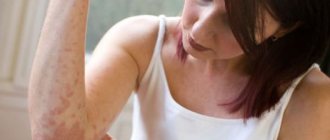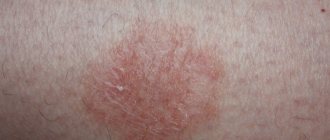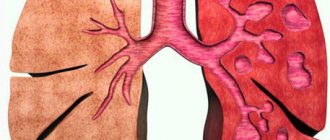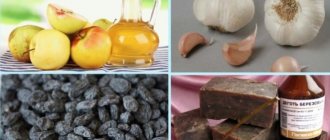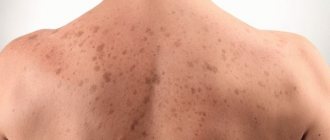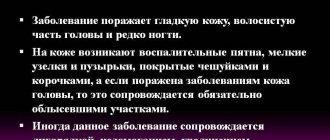Ringworm is a highly contagious fungal disease that affects smooth human skin, scalp and nail plates.
This pathology is one of the most studied. In medical terminology, it has several names, depending on the type of pathogen that provoked the development of the disease. Most often, clinicians call it dermatomycosis, dermatophytosis, dermatophytosis, as well as trichophytosis and microsporia.
Microsporia is an anthropophilic and zoonotic disease transmitted from person to person and from domestic animals. Anthropophilic trichophytosis is a fungal infection that is transmitted only from person to person. Zoonotic trichophytosis is transmitted to humans from cattle, rodents, etc.
Ringworm in humans - what is it?
Ringworm is a fungal infection of the upper layers of the skin. The causative agents of the disease can be two types of fungus:
- microsporia;
- trichophytosis.
Many sources do not distinguish between these two pathogens, which, in fact, is wrong to do. Despite the fact that they look almost identical (their differences will be discussed in more detail below), they must be treated completely differently.
The disease is different from other types of lichen. This species causes patches of baldness on the scalp or pink, round patches on the rest of the body.
The disease affects both people and animals; there are even subspecies of trichophytosis and microsporia, which can only be found in certain representatives.
Some of them are dangerous only for humans, others only affect animals, but there are also forms of the pathogen that have learned to take root in both biological species.
To survive on its host, a fungus must learn to camouflage itself and develop as inconspicuously as possible. Because of this, many patients skip the incubation period of ringworm, thereby allowing the pathogen to gain a foothold in the body.
Transmission routes
The disease is transmitted through household contact, like many other types of lichen. A person becomes infected from an animal by stroking its fur or other touches. Children usually become infected with ringworm from kittens and puppies they play with and handle.
The problem is that animals infected with ringworm do not always show external manifestations of the disease, however, this does not make them any less dangerous.
Infection from humans occurs through household contact - sleeping together, sharing combs, towels and other household items that touch the affected areas.
It is not necessary to come into direct contact - the ringworm fungus is so tenacious that it can persist on objects for a long period of time (from several months).
Children are most predisposed to developing the disease, since an adult has already formed a conditionally pathogenic microflora on the skin.
Ringworm will not be able to settle and grow so easily if a person’s own microflora and immunity come into conflict with the irritant.
Therefore, parents of small children (under 12 years old), as well as those who suffer from skin diseases and have weakened immune systems, should be especially careful.
It is worth noting that you can become infected when particles that are already infected with this fungus get on the skin. Next, it penetrates into cells.
These fungi are able to penetrate the bulbs and destroy the hair.
And on earth they are able to survive for up to 3 months. Once on human skin, spores can cause pathology.
Causes
Brief contact with a carrier of the disease or another source of infection does not always result in the development of a pathological process on the skin, since the proliferation of the fungus occurs only under certain conditions .
The creation of an environment favorable for their activation is facilitated by factors such as:
- neglect of personal hygiene rules;
- nervous shock, constant stress and depression;
- physical fatigue;
- violation of sanitary standards in public places;
- decreased skin elasticity due to prolonged exposure to water;
- lack of vitamins and minerals in the body;
- diseases of the gastrointestinal tract;
- drug and food allergies;
- increased body sweating;
- violation of the integrity of the skin;
- frequent contact with animals or the ground.
Important!
Microsporia is often diagnosed in people with a hereditary predisposition to dermatological diseases.
Diagnostics
The presence of the disease is determined only by collecting anamnesis. The diagnosis of ringworm is made by a dermatologist or trichologist. The analysis must be performed in a clinical setting.
Based on appearance, the doctor will be able to make an approximate diagnosis and refer the patient for a thorough examination, but the pathogen can only be identified using special techniques.
At the moment, ultraviolet lamps with a Wood filter are widely used. The ringworm fungus glows blue (blue-white with trichosporia) or green (with microsporia).
The surface of the skin may be scraped and a few hairs collected. The subject of analysis is examined under a microscope; the waste products of the fungus are visible both on the skin and on the hair, inside the hair shaft.
The material can be sown in special media, where microflora grows for 7-10 days. In this way, not only the type of pathogen is determined, but also its sensitivity to antifungal agents from various families.
How does the disease progress (and what are the consequences)?
Ringworm uses the structural protein of hair to grow and reproduce. It eats the keratin that makes up the hair and destroys the structure of the hair shaft. For this reason, the patient develops bald spots that have selective localization.
The spots do not exceed a few centimeters in diameter and have a round shape. The appearance and shape may vary depending on the pathogen. The first signs of the disease are itching, peeling and redness of the skin.
If a patient notices any changes in his condition or the condition of his own child, even before they become pronounced, he should be examined for the likelihood of infection.
If a person works, studies or is in a group, then there is every reason to believe that a mass infection has occurred.
Timely cured ringworm does not pose any threat to the health or appearance of a person. Permanent baldness occurs only in cases where the patient has neglected his own condition and foci of the disease began to cause wounds on the upper layers of the skin.
In such cases, scars form that cannot be removed, and the hair in these places stops growing.
The course of the disease of ringworm and its cure should further be divided according to the type of pathogen, because in each case there are special nuances characteristic only of one or another type of fungus.
Each pathology occurs according to the following scheme:
- incubation period;
- the initial stage, turning into an acute form;
- outcome of the disease;
- consequences (not always observed).
For each type of pathogen, this scheme occurs differently, so they should be considered independently of each other.
How to treat superficial trichophytosis of the scalp?
The main goal of therapy is to eliminate the causative agent of the disease – the fungus. To effectively combat pathogens and eliminate the symptoms of pathology, the patient is prescribed antifungal drugs , special detergents, solutions and diet therapy.
Ointments
Therapeutic ointments are intended for external use, therefore, if used correctly, they act directly on the lesion without affecting healthy skin. The most popular and effective remedies against microsporia are:
- Salicylic ointment - has anti-inflammatory and disinfecting properties, destroys fungus and relieves redness.
- Sulfur ointment - has keratoplastic and antifungal properties, relieves symptomatic manifestations of the disease and has a beneficial effect on the skin.
- Sulfur-tar ointment is a product with antiseptic, antibacterial and antifungal effects. Disinfects the surface of the epidermis, relieves swelling of tissues.
"Important!"
Gels and solutions
Preparations in the form of gels or solutions are actively used in the treatment of lichen, since such products are quickly absorbed, odorless, and practically do not stain or stick together the hair. Solutions can also be used as a pre-treatment before applying ointments.
The list of the most effective gels and solutions against microsporia includes:
- Mycogel-KMP is an antibacterial and antimycotic gel.
- Nitrofungin is an antifungal solution that reduces the symptoms of the disease.
- Exifin is a gel that has a fungicidal and fungistatic effect.
- Yoddicerin is an antiseptic solution with an anti-inflammatory effect.
Pills
Medicines in tablet form are prescribed exclusively in cases where there is deep damage to the follicles on the scalp and diffuse rashes appear. With superficial trichophytosis, such symptoms are not observed, which means that there is no need to take pills.
Shampoos
For microsporia, antifungal shampoos are prescribed to destroy the fungus, eliminate irritation, and cleanse the skin and hair of scales. Shampoos are simple and easy to use , they help stop hair loss and strengthen it, so patients are advised not to give up the use of cleansers.
Among the products offered by manufacturers, the leading positions are occupied by Sulsena, Nizoral and Ketoconazole shampoos.
Diet
The diet of patients with trichophytosis should be complete and balanced. Your daily diet should include healthy foods rich in vitamins and minerals , meat dishes, fresh vegetables, and fermented milk drinks.
You should avoid fast food, foods with food additives, spicy and fried foods, alcohol, store-bought juices and carbonated drinks.
Traditional medicine treatment
The use of alternative medicine should occur in combination with traditional medications and shampoos as an adjuvant therapy.
When using them, it is important to take into account the presence of contraindications and allergies, because some components can cause a negative reaction of the body in the form of a rash, severe itching and burning.
To treat trichophytosis at the initial stage of development, infusions and decoctions (chamomile, calendula, celandine), propolis, tar and compresses with apple cider vinegar in a concentration of 6% can be used.
Acute and chronic forms
Pathology can occur in acute and chronic form. If the patient does not take all necessary actions to eliminate the pathogen, then the lichen can become chronic and torment its carrier with stable remissions.
For this reason, you should immediately start taking antifungal drugs with a narrow focus to prevent the fungus from persisting in the body. This rule is especially true for adults who are less susceptible to ringworm disease.
Trichophytosis (4 stages)
The causative agent of this type of lichen is the fungi Trichophyton Violaceum and Tonsurans, which affect various areas of the body. It can develop in one or several areas at the same time.
Here are the features of trichophytosis:
- Incubation period. Lasts about two weeks and appears after the 10th day. Until this period of time, the patient does not observe any changes in his own condition.
- Acute form. The first signs of ringworm are, as a rule, inflamed oval or round spots without clear boundaries. The hair also begins to break at a distance of 1-2 mm from the root, around which black spots appear. It is through them that, in advanced stages, one can visually diagnose the disease and determine its causative agent.
- Outcome of the disease. If a child under 12 years of age is infected with this form of lichen, then it is more likely that the pathology will go away on its own during puberty. In adults, this problem can persist much longer. The greatest danger is posed by women who are unaware of their condition and pass the pathology on to their children during childbirth.
- Consequences. The disease does not lead to lifelong baldness and does not pose a serious danger to the body, however, it creates a comfortable microflora for other skin diseases.
Microsporia
The main distributor of this pathology are fur-bearing animals, however, lichen can infect people and be transmitted between any carriers.
Among the Microsporum fungus, two common species are Ferrugineum and Lanosum (rusty and fluffy, respectively).
Below are the features of microsporia:
- Incubation period. When transmitted from an animal - up to 7 days, from a person - up to 6 weeks. This difference has a logical explanation, because any pathogen tries to penetrate and coexist in the body as unnoticed as possible by its carrier. A pathogen that has taken root in the human body already has a camouflage mechanism, whereas an animal fungus has more aggressive behavior. The incubation period lasts from the moment of infection until the appearance of the first symptoms and ranges from 1 to 6 weeks.
- Acute form. The disease begins to manifest itself with spots and obvious peeling of the skin. White scales appear on the surface of the spot, which do not cause itching. Then a bald patch forms at the source of infection, the diameter of which can reach 5 cm. Then the spread of small bald patches, up to 2 cm in diameter, begins. The hair breaks off, as in the case of trichophytosis, but at a distance of about 5 mm from the root. The accumulation of fungal spores appears in the form of small, barely visible rings (may have a cylindrical shape).
- Outcome of the disease. Patients may experience both disease progression and spontaneous resolution. The transition to the chronic stage is fraught with the occurrence of related problems.
- Consequences. Advanced stages of the disease, with damage to the deep layers, can lead to the formation of scars, which gives the appearance of bald patches.
Classification
The disease can occur according to one of the described types:
- Infiltrative - the inflammatory element has a clear expression, a cluster of spores is faintly visible, but at the level of 3 mm a hyperemic area appears;
- Infiltrative-suppurative - has a more pronounced expression of inflammation, the hyperemic area rises above the skin up to 4-5 mm. In the same area, blisters form, containing purulent fluid inside. Remains of broken hair are easily removed by pulling; they are affected by purulent crusts. In advanced stages of the disease, painful ulcers may form in the deep layers of the skin, intoxication of the body occurs, and the temperature rises;
- Exudative - blisters filled with serous fluid form in the affected areas. Over time, they burst, the liquid covers the skin and glues the dead scales together, thus forming a yellowish crust. Removing these crusts exposes moist areas of infection;
- Trichophytoid is a sluggish process, scattered over the entire surface of the head. Small foci of the disease either form small bald patches or are absent altogether and do not bother their carrier;
- Seborrheic - received its name for its similarities with seborrheic dermatitis. This type of lichen does not form a receding hairline and does not break hair, but it helps to thin out the hair. There is a sluggish course of the disease, there are no obvious foci, and there are no boundaries of spread.
Advanced stages of the disease contribute to the deterioration of the patient’s condition and lead to hypertrophy of the lymph nodes.
Question answer
The treatment period ranges from 14 days to 2 months.
The period directly depends on the stage of development of the disease at which the patient consulted a doctor and began treatment. With normal immunity, recovery occurs quickly, but if the balance of natural processes has been seriously disturbed, then the period of taking the medications will have to be extended. Many patients stop taking medications immediately after they get rid of the external symptoms of the pathology. This cannot be done - eliminating the symptoms does not guarantee getting rid of the fungus; you will have to take substances for some time to consolidate the results. To prevent ringworm, you should follow basic hygiene standards and avoid contact with street animals. You need to be especially attentive to young children; if any suspicious symptoms are detected, you should immediately undergo diagnostics to promptly stop the development of the disease.
Yes, this type of lichen is contagious.
Which doctor should I contact?
If an adult or child has symptoms of ringworm, you should immediately consult a doctor. This could be a dermatologist or infectious disease specialist.
The doctor, using the diagnostic methods available to him, will confirm or deny the fact of infection and prescribe the appropriate treatment. It is worth remembering that without treatment, ringworm can provoke very unpleasant consequences in the form of baldness or suppuration, and can also be spread to other people.
In addition, there is a possibility that the symptoms of ringworm hide diseases such as atopic dermatitis, psoriasis, lichen planus, alopecia areata, etc.
Read more: Alopecia areata in children and adults
What to do if you have hair problems in the background?
As noted earlier, seborrheic dermatitis can develop against the background of ringworm - the hair becomes dirty immediately after several hours from the moment of washing it.
The fact is that all healthy processes on the surface of the skin are disrupted, including the functioning of the sebaceous glands. To eliminate the consequences, medicated shampoos such as Ketoplus or Nizoral are used.
Sulsena paste can be used, which contains active substances to normalize the functioning of the sebaceous glands on the scalp.
Is it possible to wash your hair if you have shingles?
Due to the fact that treatment of lichen on the head lasts from a couple of weeks to several months, it is impossible to avoid water procedures. In addition, lack of hygiene, on the contrary, worsens the course of the disease and increases the risk of secondary infection.
Doctors usually advise completely shaving your head, as this makes it easier to carry out medical and hygienic procedures. To do this, you should use a hair clipper.
For washing your hair, special shampoos containing ketoconazole and other antifungal substances are used. It is also permissible to use tar soap and products containing selenium and sulfur.
Signs and treatment in children
Ringworm disease mainly affects children under 12 years of age. By this time, babies do not have time to develop either immunity or opportunistic microflora. Therefore, the condition of children must be treated with the greatest attention.
It is necessary to exclude games with street animals, monitor the child’s surroundings, and help him observe basic hygiene standards.
Both diseases can occur secretly, the patient will not even notice changes in his condition or they will be too mild. In such cases, the problem goes away on its own during puberty. In adults, the problem is more serious.
Treatment for ringworm is the same as in adults, however, doctors may prescribe topical ointments and avoid taking oral medications.
Antifungal substances are extremely toxic and can negatively affect the health of children, so you should treat them with care and not start taking them without the advice of a specialist.
Prevention
The main goal of preventing the development of ringworm is the timely identification and treatment of patients with signs of one or another form of ringworm. Children's institutions must conduct regular medical examinations. A sick child (if one is identified) must be isolated from the team, and his things must be quickly and efficiently disinfected.
Next, you should examine all people who have been in contact with someone who has dermatomycosis, and, if necessary, prescribe treatment. At the same time, it is very important to regularly examine pets and, if pathological foci are identified, carry out the necessary treatment procedures.
What to do if you have been in contact with a sick person?
If you know that, for example, your son or daughter has petted an animal that has ringworm, it is worth knowing what to do in this situation.
- First, wash your hands using antifungal soap. This could be, for example, laundry soap.
- Wash your entire body with the same product. Be careful not to damage the skin, because this makes it easier for fungi to penetrate the skin. This is why do not use a hard washcloth.
- You can wash your entire body with a preparation called Citeal diluted with water. This is an effective remedy for fungus.
- Wash your hair with a special shampoo that destroys fungi. This could be, for example, Nizoral.
- Don't put off these actions. In addition, after 5 days it is better to visit a doctor to make sure that there is no fungus on the body.
By the way, after treatment it is also worth getting checked, washing all the patient’s things, and thoroughly cleaning the room.
It is advisable to isolate the patient from healthy family members, remove all toys and other things, as spores may get on them.
ethnoscience
As an additional method of treatment, you can use alternative medicine, which involves the use of natural remedies to get rid of trichophytosis.
The most popular folk recipes:
- Pour boiling water over a small amount of black raisins, leave and grind. Apply to stains several times a day. The therapeutic effect is achieved after just a few days of regular use.
- Mix plantain juice with alcohol and birch ash. Use the resulting mixture several times a day for external application.
- Lotions made from fresh pumpkin juice work well against itching and other manifestations of ringworm.
- Chamomile decoction is the most effective remedy for treating trichophytosis on the head.
- Alcohol tincture of propolis, which you can prepare yourself or buy at any pharmacy.
- It is useful to make lotions for trichophytosis lesions from a mixture of vinegar and camphor oil.
All traditional methods used must be agreed with a dermatologist, and they cannot act as primary therapy. Neglecting prescribed drug treatment is unacceptable.
During the treatment process, it is very important to follow hygiene rules, wash the patient’s clothes and underwear in hot water, and be sure to iron them. Carry out daily wet cleaning of the premises using disinfectants and ventilate the rooms. You can use aromatherapy and turn on the aroma lamp, adding to it a mixture of water and a few drops of essential oils that have disinfecting and cleansing properties. For example, tea tree or lavender ether, etc. After completing the course of treatment, you need to take a control test to ensure that the fungal infection has completely disappeared.
Expert opinion
- Cosmetologist
- Surgeon
Anna Avaliani
practicing cosmetologist
If you notice strange rashes on your body, go to the doctor. The fact is that in this case, competent diagnosis is needed. In general, ringworm is not specifically dangerous to human life, but it can lead to some troubles. If you do not start treating it in a timely manner, then you may experience baldness in the affected area in the future, and hair will never grow on it again.
Aisha Baron
plastic surgeon
Treatment of pathology is individual.
Initially, it is worth deciding on the type of lichen, since treatment may differ. If the disease becomes chronic, you will need to use antifungal medications, local remedies, vitamin complexes, and strengthen the immune system. This is all the information you need to know about ringworm. Armed with this knowledge, the patient will be able to timely diagnose this disease in himself or his loved ones and prevent its development.
The treatment will not cause much concern for patients, so it should be started promptly and without delay.
General recommendations
Direct treatment of the disease will not be effective if you do not adhere to some skin care dogmas.
The patient's bed linen is washed separately. Before the procedure, it is better to soak it in a solution mixed with disinfectants. After washing, the bed must be ironed thoroughly. In the patient’s personal room, as well as in places with large crowds of people, it is necessary to carry out high-quality wet cleaning every day. All personal items of the patient are regularly treated with antiseptics. It is better to hide all soft toys and household items that are difficult to clean during the treatment period. Indoor furniture is covered with cellophane.
A person diagnosed with tinea pilaris should wear a scarf on their head at all times. If the symptoms of the disease appear not only on the head, but also on the body, the patient should choose only clothes made from natural fabrics, which are recommended to be changed every day.
Daily showers are accompanied by the use of special antifungal shampoos - Nizoral, Citeal.
If the doctor advised not to wet the lichen, the wounds should be covered with cellophane film before water procedures.
Source: makushkainfo.ru

